Lotus Elise Cup 250: First Drive
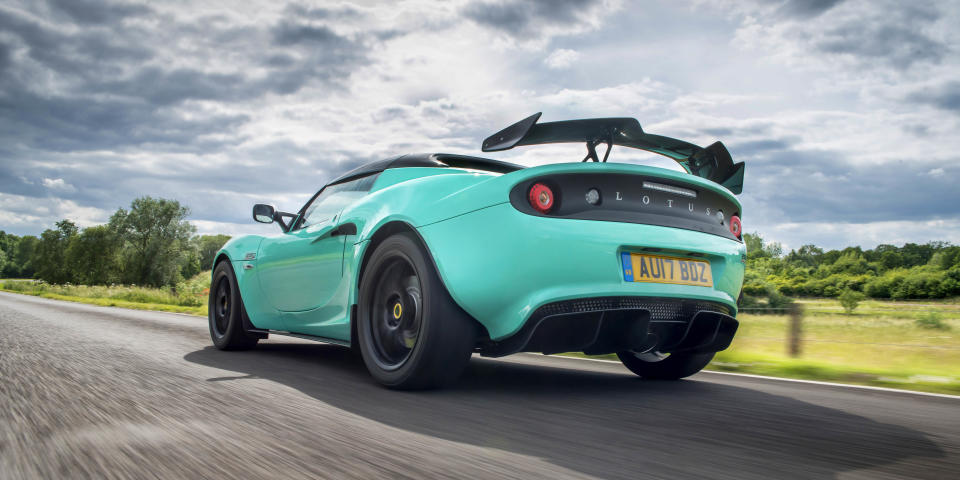
So how's this for an authentically British tale of perseverance and ingenuity: There's a tiny little company trying to beat all the major players at their own game. They come up with a stunning new chassis that proves able to accomplish miracles with a relatively modest engine. It handles like a dream, effortlessly outmaneuvering rivals with far more firepower. However, there's a bit of an arms race going on, so near the end of the vehicle's lifetime they give it a supercharged engine with more than twice the power of the debut model, plus some new wings. Thus equipped, the __________ ____________ is able to fly circles around the German competition. There's just one problem: most of the American market prefers the Mustang.
Now, if you spent your childhood with your nose in World War II history the way that I did, you will easily recognize that the two blanks above can be filled with "Supermarine" and "Spitfire." After all, the prototypes for the Spitfire set world speed records with "just" 1,030 horsepower thanks to a brilliant airframe and some truly exemplary engineering. By war's end, however, the final variants of the Spitfire were making 2,120hp and hitting a top speed some 110 miles per hour above what the original plane could manage.
If you'd rather discuss modern cars than historic aircraft, however, allow me to suggest a second way to fill those blanks: "Lotus" and "Elise." The Mk1 Elise, which was never sold in the United States, was powered by a 118-hp Rover K-series four-cylinder. By the time the car was facelifted for US consumption, the old British boat anchor had given way to a free-revving, 189-horsepower Toyota transplant.
The current Elise no longer meets Federal requirements for public-road use in the United States. The next Elise, which is scheduled to arrive in three years or so, will be road-legal. This leaves American fans of the car in a bit of a pickle. The resale value for the relatively low number of Elises on these shores has soared lately. So is it better to pay top dollar for an old Elise, or save your pennies for the next model? It's a question with no easy answer.
Unless, that is, you only want to drive your Elise on the racetrack. In that case, you should be aware that Lotus has followed the example set by the fellows at Supermarine some seventy-five years ago. They've supercharged the Elise to 243hp, more than double the original figure, and they've given it a stunning new aero package. The best news of all? Lotus Cars USA will be happy to bring one to you, as long as you are willing to keep it off the public roads.
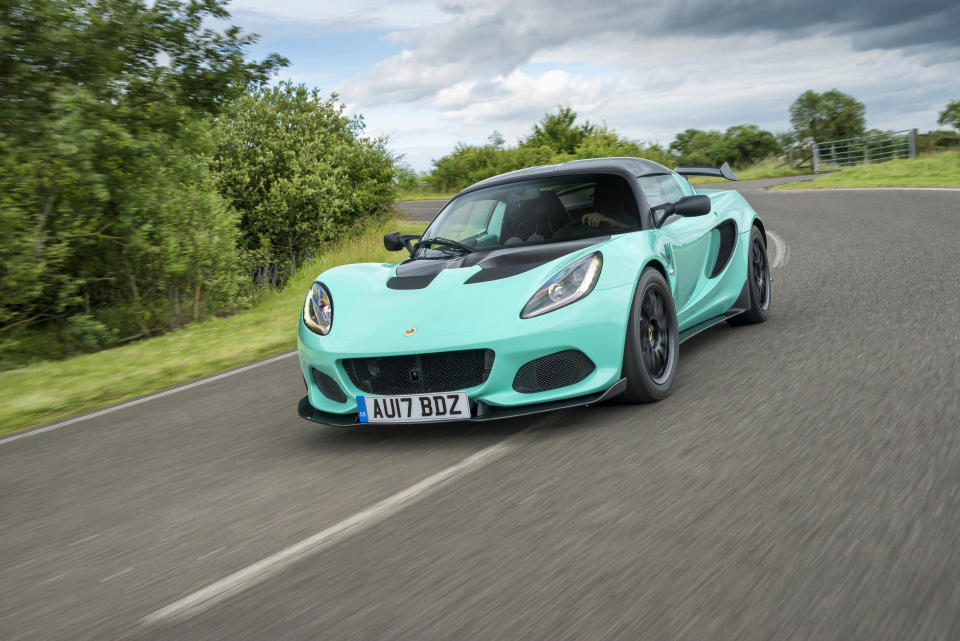
Sadly, that single caveat is a bit of a heartbreaker, because the new Elise Cup 250 isn't just a stellar track car; it's also extremely accomplished in everyday use. This past week, I was given a chance to try a left-hand-drive version around the test track in Hethel, UK before taking a right-hand-drive Elise for a spin around a variety of British motorways, A-roads, and one-and-a-half-lane "B-roads" where the pheasants run free and oncoming traffic requires a degree of cooperation that would be impossible in the United States.
At its heart, the Elise Cup 250 is based on the same bonded (meaning glued) aluminum chassis that, with some modifications, has served all Elise and Exige variants for more than two decades. Above that, it's pretty much what the British call "all change." The double wishbones front and rear feature Bilstein shocks with Eibach springs in a "coaxial" or coil-over arrangement. The bodywork is all new. Gone is the insectile, squinting look of the US-market Elise. Today's car is far more handsome and sports high-quality new headlight modules that are certain to arouse equal amounts of griping and envy in the American Lotus-eaters community. The rear end swaps out the old quad-light arrangement for separate brake and backup lamps in a blacked-out concave tail. It's a small detail but one that goes a long way to bring the look of the Elise up to date.
Like the Exige Cup 380 reviewed last week, the new Elise has a T45 steel rollover bar tucked beneath the bodywork. Every potential new owner should ask to see the photos of a half-built Elise; it would go a long way towards reassuring them about the survivability of the chassis in a rollover. Best of all, unlike with the half-cages found in some trackday specials there is no need to wear a helmet to protect your head from bumping it in a crash. I'm profoundly nervous about the unpadded bars I've seen in some factory hot-rods lately; if you've ever been hit at racing speeds you know that your body can flop around in ways that the designers (of both the car and the human being) did not intend. In the case of the Elise, the rollbar is tucked behind the bodywork.
The now-familiar Toyota engine is supercharged to 243hp at 7200rpm and maintains 184 lb-ft from 3500rpm to 5500 rpm. It is exclusively paired with a six-speed manual transmission that features the slick new Lotus open-mechanism shifter and is positive enough in its gates for someone with little left-hand shifting experience, like your humble author, to never miss a gear. The Cup 250 is supplied with the Lotus carbon buckets which are manufactured in house and can be trimmed with the material of your choice to include Seventies-style red tartan fabric. They are light enough to lift with one hand but they also fit my six-two, 240-pound, 47.5-inch chest frame.
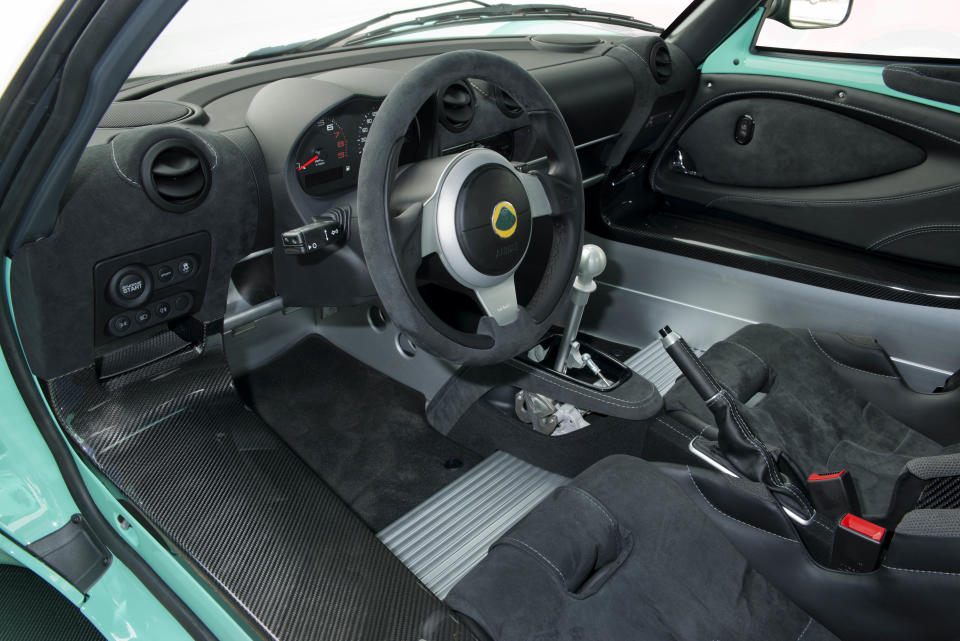
During an hour-long road drive, I was impressed by the Elise's remarkable on-road composure. The US-market cars were famous for squeaking and rattling but this appears to be entirely sorted out now. Gone, too, is the nervous ride of the earlier version. This hyper-Elise soaks up pavement waves without incident and changes direction over bumps without complaint. Of course, not even the smallest and most rural English road has potholes and ripples like the average American highway, so it was impossible for me to guess how well the Lotus would handle a Detroit-area interstate. On-track you should be better than fine.
Thrust from the supercharged Toyota engine is instantaneous and consistent. Jean-Marc Gales, the urbane and enthusiastic Lotus CEO, likes to point out that the Cup 250 has the Boxster S beaten for power-to-weight ratio. This is entirely due to the sub-2100-pound curb weight, which can be cut further with recourse to an options list that includes a $7,000 titanium exhaust and well over $15,000 worth of carbon-fiber body parts. If you are a current Porsche owner, however, you will rejoice to find out that the lithium-ion battery comes standard.
It seems hard to believe that any Boxster could keep the little Lotus in sight on a curving back road. Pure thrust is part of that, but just as importantly the Elise is usefully narrow both inside and out. Where modern Porsches impose a sort of Panamera-style console between the front-seat occupants, the Elise squeezes you right up against your passenger in a fashion that will be familiar to anybody who has owned a modern McLaren or an air-cooled 911. It's a great car for first dates, as long as you fancy the other person.
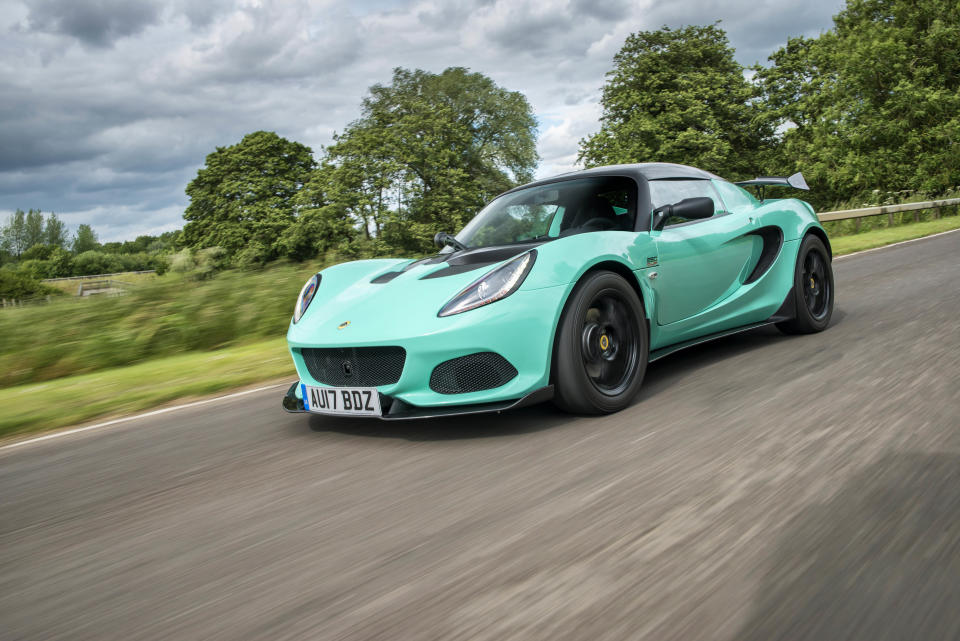
If only the top came off a little easier. Mazda offers a one-hand release and throw for its MX-5 soft top, while Porsche offers one-button operation in the Boxster. Even the Corvette can shed its targa top with two handles and a solid tug. Although the Elise's soft top can be quickly removed without tools, if you opt for the extra-cost carbon-fiber or composite tops they will require some time with a Torx wrench to install or remove. Let's hope the next Elise offers both soft and hard tops that can be operated quickly by hand. It would also be nice to have just a touch more room in the cabin. Not a Corvette's worth, but maybe halfway between the current Elise and the current Evora, which is completely comfortable for two sizable occupants.
Minor cavils aside, it is an unalloyed pleasure to boot the Elise down a narrow back road, confident that there is massive grip in reserve from the Yokohama A048 tires (225/45R17 rear, 195/50ZR16 front) and plenty of stopping power from the two-piston AP Racing front and single-piston Brembo rear brakes. In a situation like this, I'm reminded of Samuel Johnson's dry note on John Milton's Paradise Lost: "No man would wish it longer." On a tight back road, no man would wish the Elise Cup 250 faster than it is.
On the track, however, even turbocharged Ferraris can feel a little poky in the spaces between the corners. No surprise, therefore, that the Elise doesn't set the world on fire as a straight-line proposition; acceleration is somewhere between "Boxster S" and "Corvette Stingray," while the top speed of 154mph won't win any Internet bragging rights. Ah, but there's a catch. As with the peerless Viper ACR Extreme, the Lotus suffers a bit of a top-speed penalty that comes from having massive aero on the car. The Cup 250 generates 275 pounds of downforce at 140mph and the carbon-fiber park bench on the decklid is mostly responsible for this.
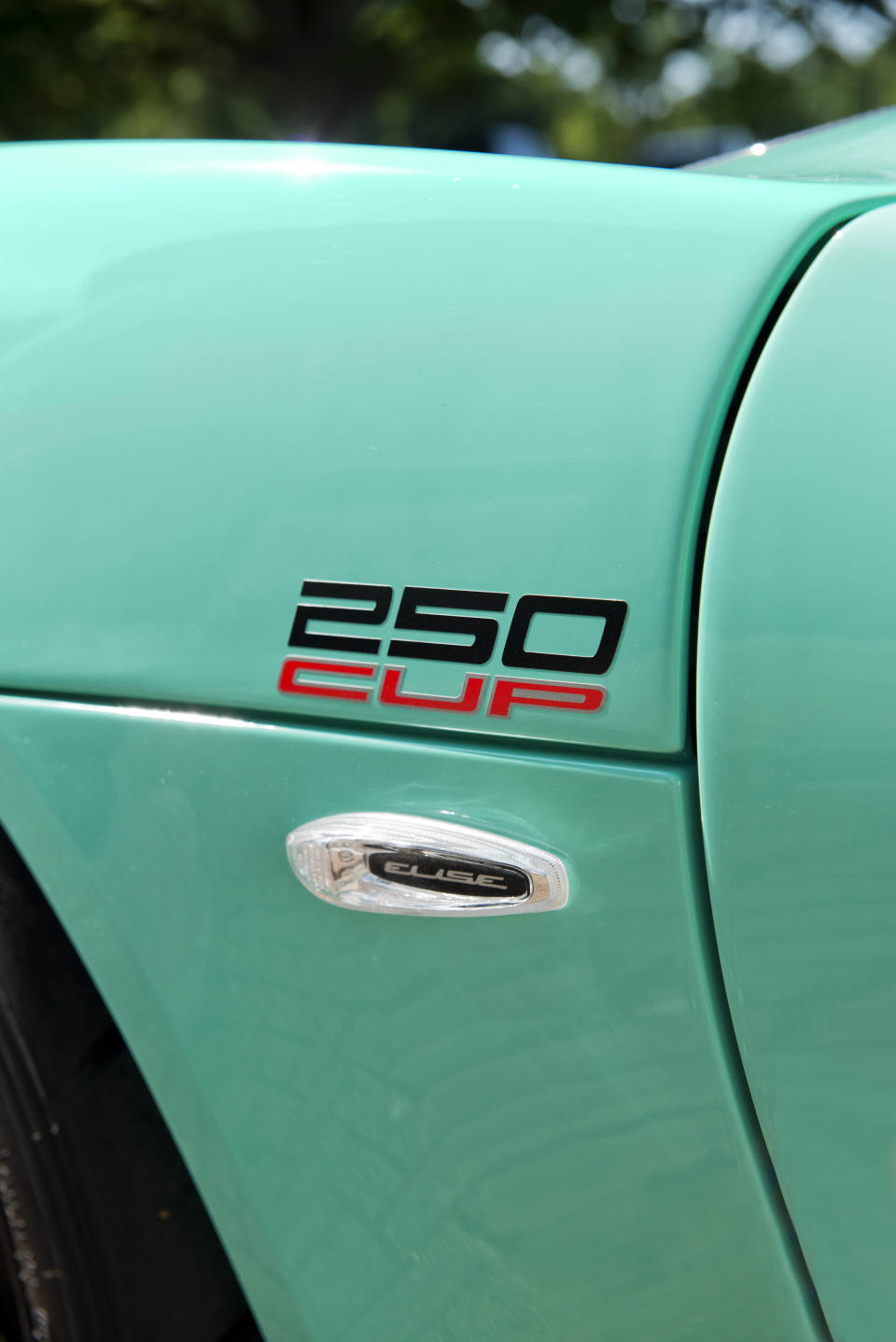
Thus equipped, the "Peppermint"-colored Elise sails through the fast back corner at the Hethel test track slightly past an indicated 110 miles per hour with the stability control switched all the way off and the throttle pinned to the stop. I've driven wingless US-market Elises with aftermarket superchargers; they are thrilling but rarely confidence-inspiring. This Cup 250, on the other hand, feels immune to even the most ham-fisted driving. The grip and power are in perfect balance.
At low speeds, the Lotus can be provoked with a lift-and-stab at the throttle, but it still won't spin. Instead, it exits the corner with the tail firmly in line and the back wheels spinning long black streaks on the pavement. Absolutely unflappable. Not everybody will want this behavior, so the men from Hethel continue to offer wingless Elises alongside their alpha dog. If you are after the minimum possible laptime, however, you will want the full aero package, in carbon fiber if you have the cash to burn.
How much cash is yet to be determined, although pricing of a fully-loaded Cup 250 is in the 65,000-pound range at home in the UK so presumably the American market will be looking at something like Corvette Z06 money or slightly less. That's a nontrivial outlay for something that will absolutely not keep up with a Z06 around anything bigger than an autocross course but some drivers will no doubt find the subtle challenge of an aero-equipped momentum car like the Elise to be superior to the stab-and-steer style one typically observes behind the wheel of the big-power Vettes.
For others, the deciding factor will be in the limitless range of personalization options available from Lotus. Color to spec of course, but the possibilities go far beyond just choosing Peppermint paint or something like that. This is a handbuilt automobile and if you want Peppermint stitching on the dashboard of your bright-red Elise it is easily done. (Please do not do that.) Each Elise comes with an engraved plaque on the dashboard featuring the name of a Lotus employee. When I quizzed the Hethel plant manager at random about the plaques on various cars, he was able to give me a quick history of every name. That's part of working in a company with fewer employees than your average shopping mall.
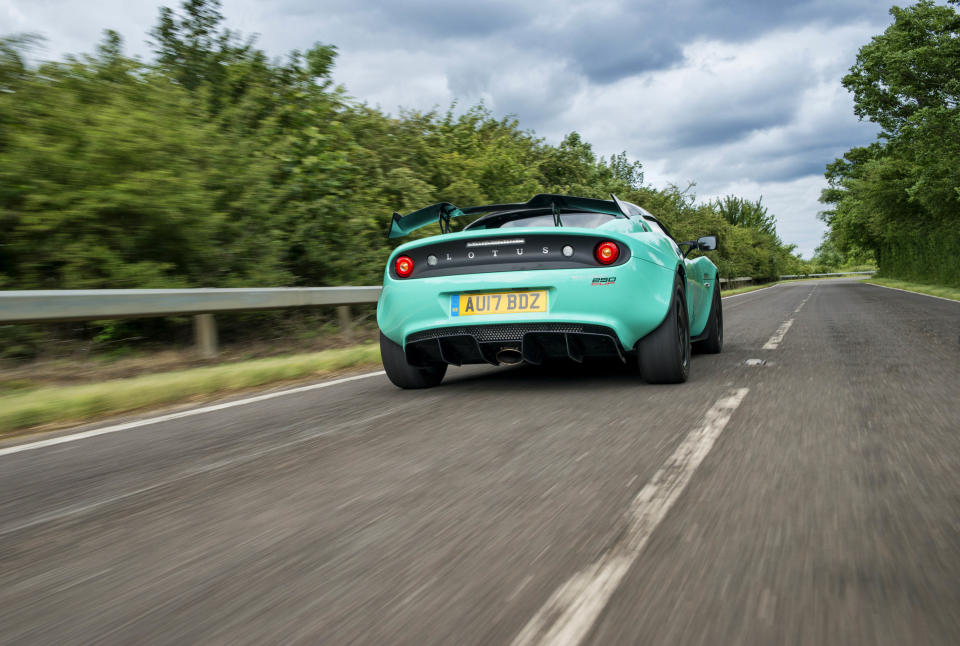
The more I think about it, the more I suspect that the Supermarine Spitfire isn't really the best metaphor for the Elise. Surely that honor should go to the deHaviland Mosquito, the wooden-framed light bomber that used unusual construction methods and a fanatical focus on weight reduction to absolutely smoke the premier air-superiority fighters of the day. Like the Elise, it was quick, light, rare, and quintessentially British. Not for everyone–but if it is for you, surely you already know how much you want it.
You Might Also Like

 Yahoo Autos
Yahoo Autos 